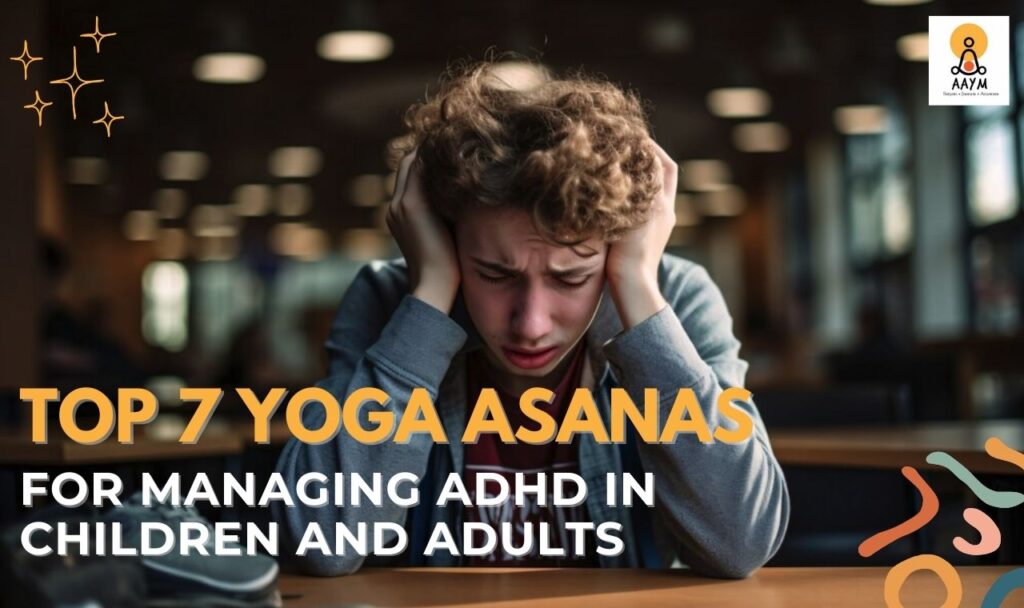Yoga, with its emphasis on mindful movement and breathing, offers a compelling approach to managing ADHD (Attention Deficit Hyperactivity Disorder) in both children and adults. Its practices promote tranquility, improve concentration, and help mitigate hyperactivity and impulsivity, making it a valuable complementary strategy for those seeking to manage ADHD symptoms. Below is a curated list of seven yoga asanas and breathing techniques specifically beneficial for individuals with ADHD, which enhance focus, reduce restlessness, and nurture a sense of inner peace.
1. Tree Pose (Vrksasana)
This balancing pose enhances concentration and focus by requiring participants to fix their gaze on a single point (Drishti). The act of balancing on one foot also helps improve core strength and stability, offering a grounding effect that can be particularly beneficial for those with ADHD.
2. Warrior II (Virabhadrasana II)
Warrior II is a powerful stance that fosters a sense of strength and confidence. It aids in improving focus and stability, while the physical exertion involved helps expend excess energy, which can be therapeutic for individuals with hyperactivity disorder.
3. Butterfly Pose (Baddha Konasana)
This seated pose is excellent for calming the mind and reducing anxiety. It helps stretch the inner thighs and knees, promoting relaxation. The simplicity and soothing nature of the pose makes it ideal for children and adults alike, encouraging mindfulness and ease.
4. Eagle Pose (Garudasana)
Eagle Pose requires concentration and balance, effectively enhancing focus and attention. The pose also stimulates the sense of proprioception (body awareness), which can benefit those with ADHD by helping them feel more grounded and present.
5. Seated Forward Bend (Paschimottanasana)
This forward fold encourages introspection and calmness. It helps relieve stress and anxiety, stretches the spine, and soothes the nervous system. Promoting forward-focused attention can help reduce impulsivity and promote calmness.
6. Child’s Pose (Balasana)
Child’s Pose is a restorative, calming pose that can act as a haven during moments of overwhelm or sensory overload, common in individuals with ADHD. It encourages relaxation, eases tension, and helps focus the mind, making it a gentle yet effective tool for finding peace in turbulent moments.
7. Breathing Techniques (Pranayama)
1. Tree Pose (Vrksasana)
This balancing pose enhances concentration and focus by requiring participants to fix their gaze on a single point (Drishti). The act of balancing on one foot also helps improve core strength and stability, offering a grounding effect that can be particularly beneficial for those with ADHD.
2. Warrior II (Virabhadrasana II)
Warrior II is a powerful stance that fosters a sense of strength and confidence. It aids in improving focus and stability, while the physical exertion involved helps expend excess energy, which can be therapeutic for individuals with hyperactivity disorder.
3. Butterfly Pose (Baddha Konasana)
This seated pose is excellent for calming the mind and reducing anxiety. It helps stretch the inner thighs and knees, promoting relaxation. The simplicity and soothing nature of the pose makes it ideal for children and adults alike, encouraging mindfulness and ease.
4. Eagle Pose (Garudasana)
Eagle Pose requires concentration and balance, effectively enhancing focus and attention. The pose also stimulates the sense of proprioception (body awareness), which can benefit those with ADHD by helping them feel more grounded and present.
5. Seated Forward Bend (Paschimottanasana)
This forward fold encourages introspection and calmness. It helps relieve stress and anxiety, stretches the spine, and soothes the nervous system. Promoting forward-focused attention can help reduce impulsivity and promote calmness.
6. Child’s Pose (Balasana)
Child’s Pose is a restorative, calming pose that can act as a haven during moments of overwhelm or sensory overload, common in individuals with ADHD. It encourages relaxation, eases tension, and helps focus the mind, making it a gentle yet effective tool for finding peace in turbulent moments.
7. Breathing Techniques (Pranayama)
- Nadi Shodhana (Alternate Nostril Breathing): This technique is known for its ability to balance and calm the mind, improve focus, and reduce anxiety. By alternating the breath through each nostril, it helps harmonize the left and right hemispheres of the brain, promoting mental clarity.
- Brahmari (Bee Breath): The vibrational sound produced during Brahmari meditatively affects the mind. It’s beneficial for reducing stress, anger, and anxiety, making it particularly suitable for managing ADHD symptoms.

